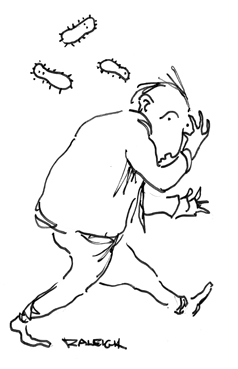Share |
Film: It’s the Little Things that Get You
By Henry P. Raleigh
ART TIMES March/ April 2012
 |
Considering how things have been going these past few years we’re ripe for a good old, leave no one standing, apocalyptic film like “Contagion.” Generally speaking, the apocalyptic genre prefers threats to human life that lend themselves handily to grand special effects — collisions with celestial objects that blow us all to hell and gone are probably the most popular crowd pleasers. Good too are invasions by uncaring aliens and ghastly mutations. Now should these fail to completely depopulate the world there is the mad scientist who mistakenly or in a pique knocks the planet off its orbit or the sun out of kilter or the moon in a sissy-fit thus giving us the choice of being incinerated, frozen, or drowned or broiled lava.
Given the apocalyptic filmmaker’s urge to completely destroy us, usually beginning with New York City or San Francisco if the first is already in ruins, it might be noticed that the pestilence film is not their weapon of choice. I imagine this is so because villains are so tiny you can’t see them to say nothing of the inability to subject to digital effects. I mean how can you digitally enhance the appearance of a virus to seem terrifying? Nor do they make fearful noises or scowl or gnash their teeth. Even under a microscope view they are little more than squiggly things darting hither and thither, to and fro without a seeming care in the world.
“The Satan Bug” of 1965 was one of the first of the pestilence films and was a refreshing change from those 50’s glut of post-atomic mutant monsters tearing us to bits. However, the virus here had been artificially created and to everyone’s disappointment disintegrate after eight hours exposure to open air — enough to decimate San Francisco but achieved little in the way of global extinction. Earlier, the 1964 “The Last Man on Earth” had started out with promising viral intentions but rather quickly settled for being your standard vampire film. This didn’t improve when remade in ’71 with Charlton Heston as “The Omega Man”. Nor can the few others that followed as “The Avalanche Express”, “Andromeda Strain” and “Outbreak” be considered satisfying from the apocalyptic point-of-view. While each starred a killer virus the bugs were simply too easily contained in rural towns which isn’t very much fun — well, unless you happen to live in one of those small towns in California or Pennsylvania. “No Blade of Grass” did imaginatively turn up a vegetarian virus that obliterated all plant life and we totally starved to death.
It was the 1980 “Virus” with Chuck Connors and Glen Ford that raised the bar on wipe-out virus films. Here the virus was called the “Italian Flu” a dig at the old Spanish flu, you see, and may have led to some nasty diplomatic exchanges between the two countries. No vaccine could stop it from destroying our planet’s population save for a small group that found refuge in Antarctica when it was discovered the virus detested cold weather. Yet, as luck would have it the survivors learned they were targeted by a passel of nuclear missiles inadvertently triggered by an earthquake. It’s hard to outdo a double apocalypse, you must admit. At the time “Virus”, a Japanese production, did stir up some feminists who noticed that women far outnumbered men among the survivors and, well sir, there was the issue of repopulating the earth. The missile strikes, I suppose, put that matter to rest.
“Twelve Monkeys” in 1995 did obliterate billions of people leaving some of us hiding underground waiting for Bruce Willis to come along and help us out. But it has been seventeen years since we’ve had to deal with a viral attack so I say it’s fortunate, all right, that “Contagion” came along to continue the slaughter lest we forget that it’s the little things that get you.
